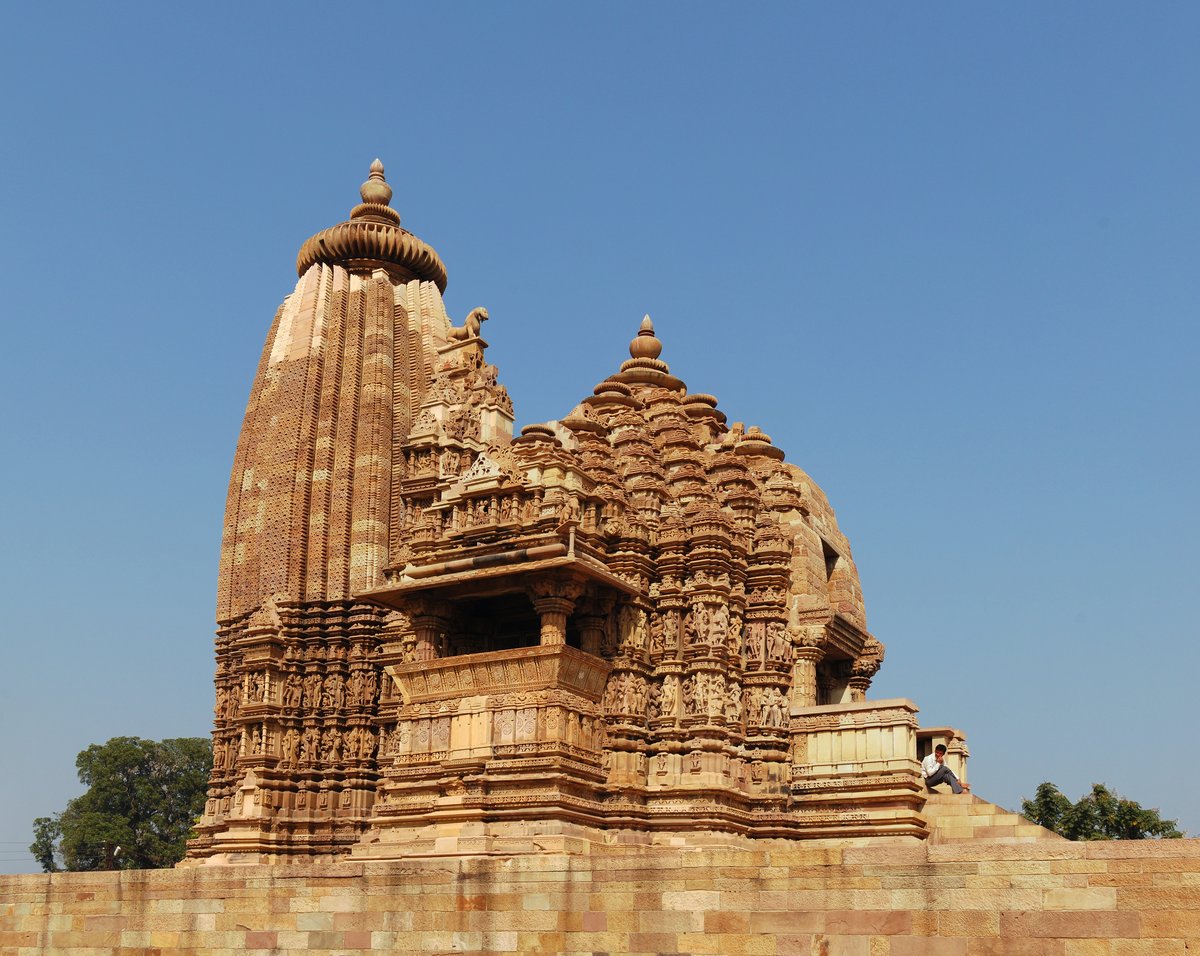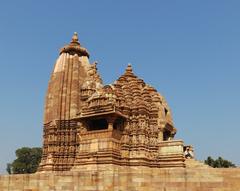
Visiting Vamana Temple: History, Tips, and Visitor Information
Publish Date: 17/08/2024
Introduction to Vamana Temple
Nestled in the historic town of Khajuraho, the Vamana Temple stands as a testament to India’s rich architectural heritage and religious fervor. This ancient marvel, dedicated to Vamana, the dwarf incarnation of Lord Vishnu, was constructed between 1050 and 1075 CE during the zenith of the Chandela dynasty’s rule. The Chandelas, who ruled central India from the 10th to the 14th centuries, were renowned for their patronage of art and architecture (Wikipedia). As part of the Khajuraho Group of Monuments, a UNESCO World Heritage Site, the Vamana Temple is celebrated for its exceptional Nagara style architecture and intricate carvings (Indian Culture). Whether you’re a history buff, an architecture enthusiast, or a spiritual seeker, the Vamana Temple offers an immersive experience that is both enriching and awe-inspiring.
Contents Overview
- History of Vamana Temple
- Visitor Information
- Travel Tips
- Special Events and Photographic Spots
- Preservation and Current Status
- Visitor Experience
- FAQ
- Conclusion
History of Vamana Temple
Construction and Architectural Style
The Vamana Temple, dedicated to Vamana, the dwarf incarnation of Lord Vishnu, was constructed between 1050 and 1075 CE. This period marks the zenith of the Chandela dynasty’s architectural and cultural achievements. The Chandelas, who ruled central India from the 10th to the 14th centuries, were renowned for their patronage of art and architecture. The Vamana Temple is part of the Khajuraho Group of Monuments, a UNESCO World Heritage Site, celebrated for its exceptional architecture and intricate carvings (Wikipedia).
The temple is situated in the eastern area of Khajuraho, approximately 200 meters northeast of the Brahma Temple. It stands on a high platform, measuring around 63 feet in length and 46 feet in breadth. The temple’s architectural layout includes a sanctum (garbha griha), a vestibule (antarala), a maha-mandapa (main hall) with lateral transepts, and an entrance porch (ardha-mandapa) (Indian Culture).
Historical Context
The Vamana Temple was built during a time when the Chandela dynasty was at its peak. The Chandelas were initially followers of Shaivism but later showed an inclination towards Vaishnavism and Jainism. This eclectic religious patronage is evident in the diverse deities and themes depicted in the temple carvings. The construction of the Vamana Temple, along with other temples in Khajuraho, is believed to be part of a broader cultural and religious movement that aimed to proliferate the Siva-Sakti cult and other Hindu traditions (Indian Culture).
Architectural Significance
The Vamana Temple is an excellent example of the Nagara style of architecture, characterized by its beehive-shaped shikhara (spire) and intricate carvings. Unlike other temples in Khajuraho, the Vamana Temple’s shikhara is devoid of subsidiary spires, making it unique. The temple’s roofed maha-mandapa is also an anomaly in Khajuraho but is typical among medieval West Indian temples (Lonely Planet).
The temple’s exterior walls are adorned with exquisite carvings that depict various gods, their consorts, female figures, and mythological characters like Varaha and Nandi. The upper row around the sanctum portrays Brahma with his consort on the south and Vishnu with his consort towards the north. The lower row contains images of Varaha, Narasimha, and Vamana. The facade is intricately carved with sculptures of various gods, their consorts, female figures, and mythological characters (Google Arts & Culture).
Cultural and Religious Significance
The Vamana Temple holds significant religious importance as it is dedicated to Vamana, the fifth avatar of Lord Vishnu. According to Hindu mythology, Vamana appeared as a dwarf to defeat the demon king Bali and restore order to the universe. This mythological event is a crucial narrative in Vaishnavism, symbolizing the triumph of good over evil and the restoration of cosmic balance (Safar Mentor).
The temple also features figures of other incarnations of Vishnu carved into its framework, along with a figure of Lord Brahma in the bhumisparsa-mudra or earth-touching gesture. These carvings not only enhance the temple’s aesthetic appeal but also serve as a testament to the religious diversity and artistic excellence of the Chandela period (Indian Culture).
Visitor Information
Opening Hours
The temple is open from sunrise to sunset. Exact hours may vary, so it’s advisable to check before your visit.
Ticket Prices
Entry to the temple is free, but if you’re planning to visit other monuments in Khajuraho, consider purchasing a combined ticket.
Guided Tours and Events
Guided tours are available and highly recommended to fully appreciate the temple’s history and architecture. Check for any special events or festivals that might be taking place during your visit.
Travel Tips
Best Time to Visit
Early morning is ideal for photography and avoiding crowds. The winter months (October to February) offer the most pleasant weather.
Getting There
Khajuraho is well-connected by road, rail, and air. The nearest airport is Khajuraho Airport, about 5 km from the temple complex.
Special Events and Photographic Spots
Special Events
Look out for the annual Khajuraho Dance Festival, which showcases classical Indian dance forms against the backdrop of the temples.
Photographic Spots
The temple’s entrance porch and the carvings on the exterior walls are particularly photogenic.
Preservation and Current Status
The Vamana Temple, like other temples in Khajuraho, has withstood the ravages of time remarkably well. The Archaeological Survey of India (ASI) has undertaken several restoration and preservation efforts to maintain the temple’s structural integrity and artistic grandeur. Today, the temple is a popular tourist attraction, drawing visitors from around the world who come to marvel at its architectural beauty and historical significance (Travel Setu).
Visitor Experience
Visitors to the Vamana Temple can explore its various architectural elements, including the sanctum, vestibule, maha-mandapa, and entrance porch. Modest dress is required, and visitors must remove their shoes before entering the temple complex. Photography is allowed, but visitors are advised to be respectful and not touch any sculptures or carvings (Safar Mentor).
The temple complex is not fully accessible for disabled visitors, as there are several steps to navigate. However, visitors with mobility issues can still enjoy the mandapa and the outer areas of the complex. The best time to visit is early in the morning when the first rays of the sun illuminate the temple, creating a mesmerizing visual experience (Revolving Compass).
FAQ
- What are the Vamana Temple visiting hours? The temple is open from sunrise to sunset. Exact hours may vary, so it’s advisable to check before your visit.
- How much are tickets for the Vamana Temple? Entry to the temple is free, but if you’re planning to visit other monuments in Khajuraho, consider purchasing a combined ticket.
- What are the best times to visit the Vamana Temple? Early morning is ideal for photography and avoiding crowds. The winter months (October to February) offer the most pleasant weather.
Conclusion
The Vamana Temple stands as a testament to the architectural brilliance and cultural richness of the Chandela dynasty. Its intricate carvings, unique architectural features, and religious significance make it a must-visit destination. Download our mobile app Audiala for more travel tips and updates, and don’t forget to check out our other related posts for more historical sites in Khajuraho.
Sources and Further Reading
- Wikipedia (2024). Vamana Temple, Khajuraho. source url
- Indian Culture (2024). Temples of Khajuraho. source url
- Lonely Planet (2024). Vamana Temple. source url
- Google Arts & Culture (2024). Vamana Temple Story. source url
- Safar Mentor (2024). Vamana Temple. source url
- Travel Setu (2024). Vamana Temple Tourism. source url
- Revolving Compass (2024). Plan a Trip to Khajuraho. source url
- OM Astrology (2024). Vamana Temple, Khajuraho. source url
- Optima Travels (2024). Vamana Temple, Khajuraho. source url
- Laidback Traveller (2024). Khajuraho Temple Guide. source url
- Outlook Traveller (2024). Your Ultimate Guide to Visiting Khajuraho. source url
- The Indosphere (2024). The Majestic Temples of Khajuraho. source url
- Thrillophilia (2024). Vamana Temple. source url
- LightUp Temples (2024). Vamana Temple, Madhya Pradesh. source url
- Tale of 2 Backpackers (2024). Temples of Khajuraho. source url

